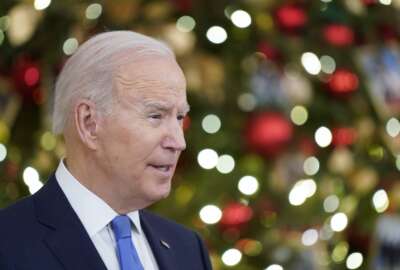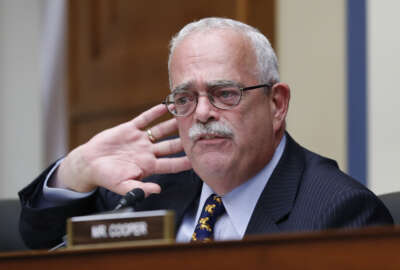Exclusive
White House to propose 4.6% raise for feds in 2023
In the annual passback document, Federal News Network has learned the Biden administration wants to give federal employees their biggest raise in 15 years.
The Biden administration wants to give federal employees their largest pay raise in 15 years.
Federal News Network has learned that the White House will propose a 4.6% pay increase for federal employees as part of its fiscal 2023 budget request. The budget request is expected to go to Congress after the State of the Union, which is on March 1, Shalanda Young, the nominee to be director of the Office of Management and Budget, told the Senate Budget Committee on Feb. 1.
The Office of Management and Budget told agencies in the annual “passback” guidance, which Federal News Network obtained, to plan for the 4.6% raise and included more funding to account for the additional salaries and expenses. The White House didn’t break down the raise in terms of locality vs. across-the-board increases.
OMB declined to comment.
The White House’s proposal is the largest in decades. The administration proposed and Congress approved an increase of 2.7% for 2022.
The pay raise in 2021 was 1% for civilian employees, while military service members received a 3% raise.
In 2020, federal employees received a 3.1% raise.
Support for the White House’s proposal on Capitol Hill will be strong among Democrats. Both House and Senate Democrats introduced the Federal Adjustment of Income Rates (FAIR) Act, which would give federal employees a 5.1% raise, in early January. The bill, more specifically, would grant a 4.1% across-the-board pay raise, plus a 1% increase in locality pay.
Other administration priorities for 2023
Along with the pay raise, the passback included a host of other directions around hiring interns, improving customer service and prioritizing cybersecurity protections for high value assets.
The Office of Management and Budget also emphasized the prioritization of diversity, equity, inclusion and accessibility (DEIA) efforts, climate change initiatives and the Justice40 programs.
For example, OMB wants agencies to submit by Feb. 15 a “detailed explanation of what resources the agency will dedicate from within fiscal 2023 Passback levels to coordinate implementation of the Justice40 Initiative. This explanation should include, at minimum, specific funding amounts used for implementation/coordination of Justice40, the number of FTEs working on implementation of Justice40, and the use of contractor support (type of support, cost and number of personnel) dedicated to implementing the Justice40 Initiative.”
Also by Feb. 15, agencies must send to OMB a “best estimate” of the number of paid and unpaid interns they plan to hire in 2022 and 2023, especially given the current uncertainty with the fiscal 2022 budget.
OMB said these efforts through Pathways, Workforce Recruitment Program Scholarship for Service or other authorities should be aligned with the diversity, equity, inclusion and accessibility strategic plan.
“To the extent funding is available, agencies are encouraged to begin implementing internship program improvements immediately and take steps to increase internship hiring for 2022,” the document stated. “Agencies are also expected to incorporate their goals for increased intern hiring into their workforce planning and human capital operating plans, and establish a plan for conversion of eligible interns, which includes consideration of the intern’s performance in addition to completing program requirements. Agencies will be required to report to OMB on their progress toward this objective on a frequent basis.”
On the DEIA initiatives, OMB told agencies to use money to hire the expertise needed to implement their Equity Action Plans, including an agency equity team lead and staff support who are dedicated full-time to these efforts.
Agencies also should “regularly conduct equity assessments, strengthen the collection, management and use of data, and staff research and evaluation capabilities. Finally, all agencies should do more meaningful engagement of underserved communities to ensure their voices inform and shape the design and delivery of federal programs. The expertise required to design and facilitate these activities should also be prioritized in agency strategic workforce management and planning activities.”
Customer experience funding
Another priority is modernizing public facing websites, particularly those that serve citizens under the administration’s customer service initiative.
OMB told agencies to “identify their websites and digital services that need to be prioritized for modernization and digitization. Agencies should continue to prioritize and identify funding for the website modernization and the digitization of services and forms that are highly utilized by the public, or that have been identified as activities outlined in Executive Order 14058.”
OMB also is encouraging the 35 high impact service providers across government to continue to build centralized, cross-cutting customer service programs, which may include hiring additional employees to support the initiatives.
The hiring of employees is a common theme throughout the passback. OMB is asking agencies to make sure they are spending money to ensure their human resources and hiring managers have the necessary tools and capabilities to bring on the talent necessary to meet all of these goals.
Specifically, OMB wants agencies to use 2023 funding for building “dedicated employees to build on their talent teams from fiscal 2022, tools to improve hiring assessment processes and funds to staff up critical staffing gaps in human resources.”
Reinvigorate the FEBs
As part of the push to improve the federal workforce, OMB is reinvigorating the Federal Executive Boards (FEBs) through a new governance and funding structure.
OMB is creating a new line of business (LoB) to fund the FEBs, replacing the current model that relies on individual agencies paying for regional FEB staff.
“Fiscal 2023 Passback levels include funding to establish a new LOB that will provide a total of $10 million for program administration and FEB staff costs,” the document stated.
OMB said the amount each agency will provide is based on the number of employees they have outside the Washington, D.C. area. Additionally, OMB said it will work with the Office of Personnel Management and the General Services Administration to move to this new governance model, which will be housed at OPM, but receive policy direction from all three agencies.
Finally, OMB also addressed the long awaited final President’s Management Agenda and cross-agency priority goals.
The administration wants agencies by Feb. 11 to send in their final draft agency priority goals, and by Feb. 23 to send in their final strategic plan that addresses their learning agendas and capacity assessments.
Copyright © 2025 Federal News Network. All rights reserved. This website is not intended for users located within the European Economic Area.
Jason Miller is executive editor of Federal News Network and directs news coverage on the people, policy and programs of the federal government.
Follow @jmillerWFED






